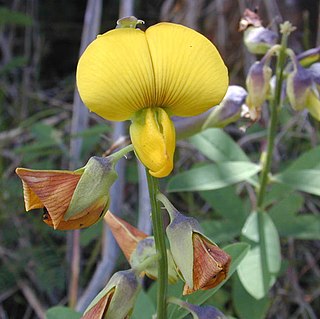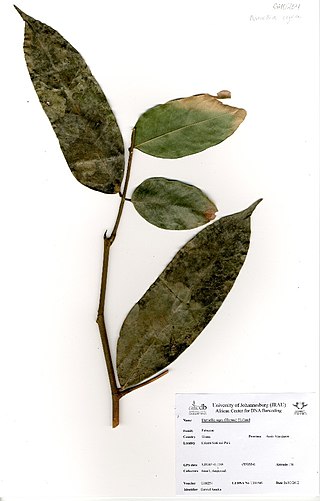
The Fabaceae or Leguminosae, commonly known as the legume, pea, or bean family, are a large and agriculturally important family of flowering plants. It includes trees, shrubs, and perennial or annual herbaceous plants, which are easily recognized by their fruit (legume) and their compound, stipulate leaves. The family is widely distributed, and is the third-largest land plant family in number of species, behind only the Orchidaceae and Asteraceae, with about 765 genera and nearly 20,000 known species.

The Faboideae are a subfamily of the flowering plant family Fabaceae or Leguminosae. An acceptable alternative name for the subfamily is Papilionoideae, or Papilionaceae when this group of plants is treated as a family.

Medicago is a genus of flowering plants, commonly known as medick or burclover, in the legume family (Fabaceae). It contains at least 87 species and is distributed mainly around the Mediterranean Basin, and extending across temperate Eurasia and sub-Saharan Africa. The best-known member of the genus is alfalfa, an important forage crop, and the genus name is based on the Latin name for that plant, medica, from Greek: μηδική (πόα) Median (grass). Most members of the genus are low, creeping herbs, resembling clover, but with burs. However, alfalfa grows to a height of 1 meter, and tree medick is a shrub. Members of the genus are known to produce bioactive compounds such as medicarpin and medicagenic acid. Chromosome numbers in Medicago range from 2n = 14 to 48.

Phaseolus is a genus of herbaceous to woody annual and perennial vines in the family Fabaceae containing about 70 plant species, all native to the Americas, primarily Mesoamerica.

The Nymphalidae are the largest family of butterflies, with more than 6,000 species distributed throughout most of the world. Belonging to the superfamily Papilionoidea, they are usually medium-sized to large butterflies. Most species have a reduced pair of forelegs and many hold their colourful wings flat when resting. They are also called brush-footed butterflies or four-footed butterflies, because they are known to stand on only four legs while the other two are curled up; in some species, these forelegs have a brush-like set of hairs, which gives this family its other common name. Many species are brightly coloured and include popular species such as the emperors, monarch butterfly, admirals, tortoiseshells, and fritillaries. However, the under wings are, in contrast, often dull and in some species look remarkably like dead leaves, or are much paler, producing a cryptic effect that helps the butterflies blend into their surroundings.

Afzelia is a genus of plants in family Fabaceae. The thirteen species all are trees, native to tropical Africa or Asia.

Crotalaria is a genus of flowering plants in the family Fabaceae commonly known as rattlepods. The genus includes over 700 species of herbaceous plants and shrubs. Africa is the continent with the majority of Crotalaria species, which are mainly found in damp grassland, especially in floodplains, depressions and along edges of swamps and rivers, but also in deciduous bush land, roadsides and fields. Some species of Crotalaria are grown as ornamentals. The common name rattlepod or rattlebox is derived from the fact that the seeds become loose in the pod as they mature, and rattle when the pod is shaken. The name derives from the Ancient Greek κρόταλον, meaning "castanet", and is the same root as the name for the rattlesnakes (Crotalus).

Canavalia is a genus of plants in the legume family (Fabaceae) that comprises approximately 62 species of tropical vines. Members of the genus are commonly known as jack-beans. It has a pantropical distribution.

Daniellia is a genus of plants in the family Fabaceae, named after William Freeman Daniell. It includes ten species native to sub-Saharan Africa, ranging from Senegal to Sudan and south to Zambia and Angola.
Englerodendron is a small genus of legumes belonging to the family Fabaceae, that are native to tropical Africa.

Tephrosia is a genus of flowering plants in the family Fabaceae. It is widespread in both the Eastern and Western Hemisphere, where it is found in tropical and warm-temperate regions.

Gliricidia is a genus of flowering plants in the legume family, Fabaceae and tribe Robinieae. Its native range is Mexico to Peru, but Gliricidia sepium has been widely introduced to other tropical zones.
Clitoriopsis is a genus of flowering plants in the legume family, Fabaceae. It belongs to the subfamily Faboideae. The genus contains a single species, Clitoriopsis mollis, a subshrub native to South Sudan and Democratic Republic of the Congo. It grows in seasonally-dry tropical forest margins, woodland, and wooded grassland.
Mastersia is an Asian genus of flowering plants in the legume family, Fabaceae. It belongs to the subfamily Faboideae. It contains two species of lianas or twining herbs. Typical habitat is seasonally-dry tropical forest, often in open places, including both wet and dry sites.

Phyllodium is a genus of flowering plants in the family Fabaceae, in the subfamily Faboideae, tribe Desmodieae and subtribe Desmodiinae. Species are found in tropical and subtropical Asia through to northern Australia.

Scadoxus multiflorus is a species of bulbous plant native to most of sub-Saharan Africa from Senegal to Somalia to South Africa. It is also native to Arabian Peninsula and to the Seychelles. It is naturalized in Mexico and in the Chagos Archipelago.It is also found in Indian peninsula. It is grown as an ornamental plant for its brilliantly coloured flowers, either in containers or in the ground in where the climate is suitable. There are three recognized subspecies. Strongly toxic like other Scadoxus species, it has been used as a component of arrow poisons and fishing poisons, as well as in traditional medicine. Common names, some of which are used for other species, include blood lily, ball lily, fireball lily, blood flower, Katherine-wheel, oxtongue lily, poison root and powderpuff lily.

Sulla is a genus of flowering plants in the legume family, Fabaceae. It includes eight species of annual herbs native to the Mediterranean Basin, including southern Europe, North Africa, and western Asia. They grow in dry Mediterranean-climate shrubland, bushland, thicket, and grassland and in semi-desert. The genus belongs to subfamily Faboideae.

Hemionitis is a genus of ferns in the subfamily Cheilanthoideae of the family Pteridaceae. Its circumscription varies greatly in different systems of fern classification. In the Pteridophyte Phylogeny Group classification of 2016, it was one of more than 20 genera in the subfamily Cheilanthoideae, and was said to have five species. Other sources treat it as the only genus in the subfamily, and so accept about 450 species. With the restricted circumscription, species are native to tropical America.

Alysicarpus glumaceus is a plant in the legume family Fabaceae.
Mucuna paniculata is a species of flowering, woody vine in the family Fabaceae, the bean family. It is native to northern Madagascar where it is locally known in Malagasy as vohinkovika. It flowers between June and August.















